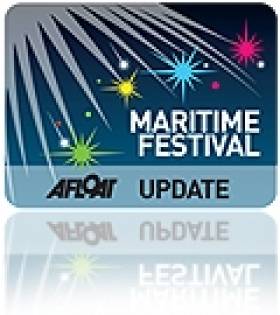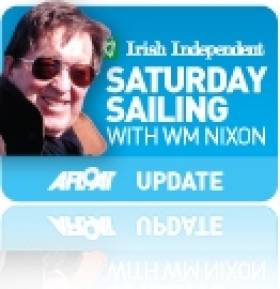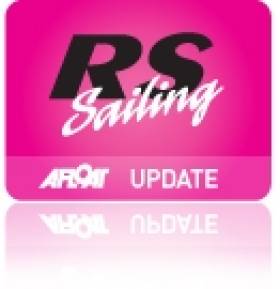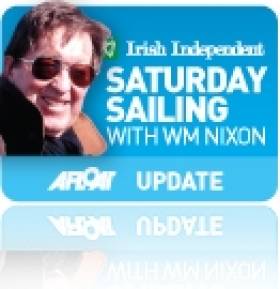Displaying items by tag: sailing
Get Afloat For Paddy's Weekend!
#PaddysDay - After months of storm-force winds, relentless rain and flooding, and often freezing conditions, there's finally some light on the horizon - as Met Éireann says the weather will be mostly dry and settled for the coming weeks.
As TheJournal.ie reports, a persistent high-pressure system is bringing us sunshine every day this week as we head towards St Patrick's Day next Monday.
That's great news for those planning to attend St Patrick's Festival events around Ireland this weekend - not least Ireland's many boaters, who will surely be itching to get their vessels out of winter storage and back on the water to enjoy the late spring and summer season.
Landlubbers in the capital, meanwhile, can also make the most of the fine weather by taking part in the annual Harbour 2 Harbour walk raising funds for mental health charity Aware.
As always, the 25km route runs between Howth and Dun Laoghaire, with participants free to walk either direction around Dublin Bay. For details on how to take part and get sponsorship see the Aware website HERE.
And while in Dun Laoghaire, why not pay a visit to the new exhibition of sailing paintings at the National Maritime Museum of Ireland.
Of Sail and Ships, which has its official launch this Wednesday 12 March, displays some of the museum's collection of some 400 paintings, charts and other images, along with winners of the Marine Institute's recent children's art competition.
Sailing As We Know It 'Is Over'? Not Exactly
#Sailing - "Sailing as we know it is officially over" is the strongest message to emerge from the two-day World Yacht Racing Forum and Yacht Racing Design and Technology Symposium held earlier this week (10-11 December) in Gothenburg.
But as Craig Leweck writes for Scuttlebutt, that grand statement doesn't speak for the majority of sailing enthusiasts not active in the "professional layer" of the sport.
No doubt the innovations and radical changes that sailing has witnessed this year, and will continue to see in coming years, will trickle down to the smaller classes and recreational vessels - and that's aside from the expected shake-up of the ISA in the New Year - but for now, posits Leweck, evolution is purely for the pros. Scuttlebutt has more on the story HERE.
Meanwhile, what do you think of the state of sailing today? Are you seeing any benefits from developments in the professional tier? Share your thoughts with us in the comments below
Irish Sailing 2013 Review – Ups & Downs & Sideways Too
In this Irish Sailing review of 2013, W M Nixon looks back on a year of the unexpected. There were reversals of fortune where some top sailors had seemed set for success, but new stars emerged to provide hope for the future. And perhaps best of all, after a gruesome start, the weather relented at mid-summer to provide one of the best sailing seasons in years.
Thanks to the diaspora of Irish sailing talent with the Paddy presence continually increasing in Australia, these days we effectively have a year-round sailing season, and major southern hemisphere events like the Sydney-Hobart are seen as an associated part of the year's events at home.
Thus New Year's Day has the useful distraction of a leisurely perusal of the results from Hobart, and January 1st 2013 was most satisfactory. Gordon Maguire may not have repeated his overall win of the 2011 race with Stephen Ainsworth's superb 63ft Loki, but he was tops of his class, comfortably out-sailing every boat of comparable size, and his second overall to Bob Oatley's hundred footer Wild Oats XI (which had also established a new course record) meant that the Irish skipper was confirmed as clear overall winner of the Australian Offshore Championship 2012-2013, a very satisfactory conclusion to the five year Ainsworth-Maguire partnership
Back home meantime, winter was tightening its grip, and even the hyper-keen Fireballs frost-biting in Dun Laoghaire found their turnouts occasionally down to single figures, though the Lasers in Howth in their 38th winter season found numbers holding up well, with prizes well spread among several Leinster clubs. The growing turnout including sailors whose fathers – and possibly even grandfathers – had sailed in that first Laser league way back in 1974. Ronan Cull won the Standards, Aoife Hopkins the Radials, and Daragh Sheridan won the Grand Masters.
But for most sailing folk, January and February are for hibernation with just the occasional emergence to honour some notable achievement from the previous season, and better still several previous seasons. So it was a very special AGM of the Irish Cruising Club in February in Dun Laoghaire when Fergus & Kay Quinlan of Bell Harbour on Galway Bay took the premier trophy, the Faulkner Cup which dates back to 1931, for the third year in a row for their exemplary global circumnavigation in the 12 metre cutter Pylades, which Fergus built himself in steel.
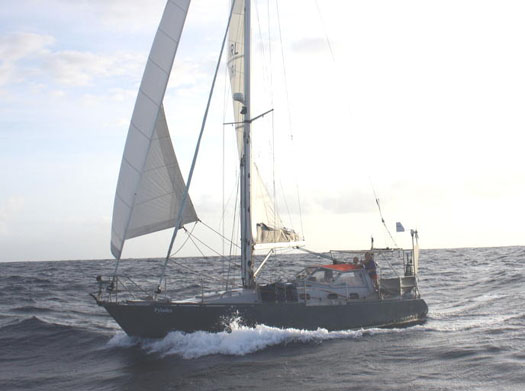
The homemade success – Fergus and Kay Quinlan's 12m van de Stadt-designed Pylades
Winter showed little sign of easing in Ireland in March, but the sailing in the Caribbean area was at its best, and at the Star Class 86th Bacardi Cup series in Miami, Cork's Peter O'Leary was right in the hunt for a podium place in the fleet of 63 boats. But having to carry a 27th after he'd discarded a 36th meant he finished 8th overall, despite his scorecard including a 1st, 2nd and 6th.
So it was a junior brother of the O'Leary clan of Crosshaven, young Rob, who was most in the sailing headlines in March, as he stood down from sailing in the Universities Team Racing Championship over the St Patrick's Weekend in mid-March at Tralee Bay SC in order to put all his efforts into organising this Firefly racing in Kerry for 28 teams which included international input.
Rob O'Leary was trebly rewarded for his altruism, for in a weekend when the rest of Ireland was suffering snow and storms, somehow Tralee Bay had its own very sailable micro-climate. And the crowded programme was handsomely completed, with the organiser having the satisfaction of seeing his own squad from University of Limerick, captained by Ross Murray, emerge as champions.
Ross Murray captained the winning University of Limerick team in the Irish Universities team Racing Championship at Tralee Bay over the St Patrick's Weekend in mid-March.
Then in the following month O'Leary had his chance at the helm, and he took it in style to make Limerick the winners of the Student Yachting Worlds Selection Trials, raced over four Saturdays in April in the SailFleet J/80s at Howth. University College Dublin having won the SYW in October 2012 by a huge margin, they'd a place as of right in the 2013 Worlds, thus Limerick were in theory poised to make the Irish 2013 challenge even more formidable. But as we shall see, the ephemeral nature of college sailing personnel meant that April 2013 was really when Irish college sailing was at its peak for the year.
There was no easy optimism about the new season during May, as a bitterly cold Spring hampered sailing enthusiasm. However, the big winds which often came with the low temperatures suited Olympian Annalise Murphy racing at the Delta Lloyd Spa Regatta in the Netherlands, and she won Gold in style. But those rugged conditions were daunting for others, particularly among the dedicated contingent sailing to the Scottish Series in wintry headwinds. Conditions relented during the event itself, but Irish boats missed out on the frame, though Liam Shanahan's J/109 Ruth, largely crewed by junior instructors from the National YC, was well in contention.
Summer arrived suddenly at the end of May, just in time to provide 24 boats of the Cruising Association of Ireland with idyllic conditions for a Cruise-in-Company to North Wales. Back home in Dublin Bay, that first Bank Holiday Weekend of June had fine weather for the visit of the Old Gaffers Association, celebrating their Golden Jubilee with a rolling Round Britain Cruise which came far enough west to take in Dublin and Belfast.
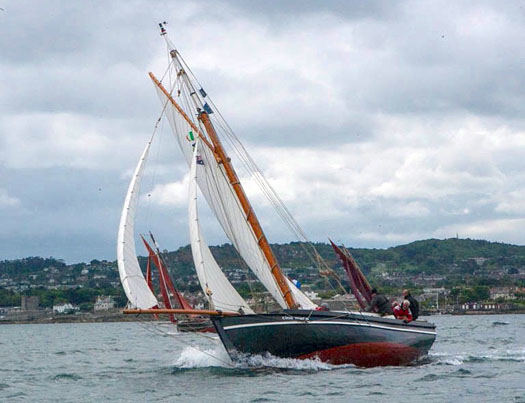
The Old Gaffers Race in Dublin Bay. This is Dutch skipper Rik Janssen's own-built steel Galway Hooker Cine Mara developing full power. Photo: Barry O'Loughlin
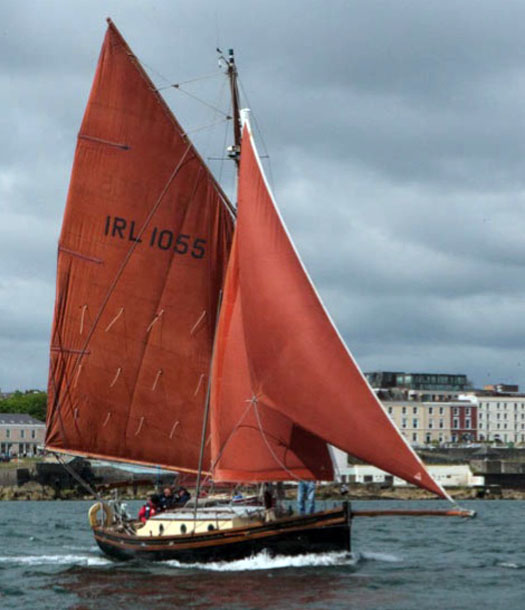
Sean Walsh of the Dublin Bay OGA won the Golden Jubilee Race Series in the bay with his Heard 28 Tir na nOg by taking third in the Leinster Plate, and then winning the Asgard Trophy. Photo: Barry O'Loughlin
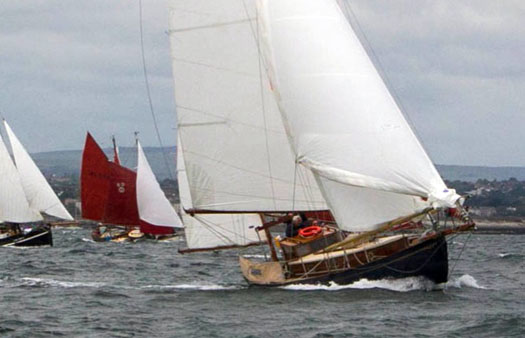
Dickie Gomes' 101-year-old Ringsend-built 36ft yawl Ainmara from Strangford Lough on her way to winning the Leinster Plate race staged by Poolbeg Y & BC of Ringsend. It was the first time Ainmara had been back to Ringsend in 90 years. Photo: Barry O'Loughlin
It was Dublin Bay – thanks in part to the involvement of the 115-year-old Howth 17s – which provided more gaff rigged boats than anywhere else except the final Golden Jubilee assembly in the Solent in mid-August, and with Dublin Bay's racing tradition, they'd sport afloat, ashore, and in the River Liffey. DBOGA stalwart Sean Walsh with his Heard 28 Tir na nOg got the best overall result by winning the concluding race for the Asgard Trophy, and taking third in the opening race for the Leinster Plate, where the winner was Dickie Gomes's 101 year old 36ft yawl Ainmara from Strangford Lough, celebrating her return to her birthplace of Ringsend after an absence of 90 years.
The biennial Dun Laoghaire to Dingle Race got going on Friday June 7th with a good fleet of 22 boats, and for much of the race it looked as though RORC flag officer Anthony O'Leary of Crosshaven was going to take both line honours and the handicap win with his Ker 39 Antix. But a parking lot for the leaders in Dingle Bay saw results being inverted to provide an exuberantly celebrated victory for Tralee Bay's Brian O'Sullivan with his veteran Oyster 37 Amazing Grace.
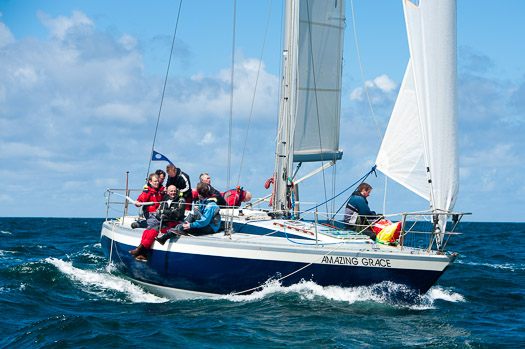
Brian O'Sullivan's vintage Oyster 37 Amazing Grace racing in the ICRA Nationals in Tralee Bay after winning the Dun Laoghaire-Dingle Race overall. Photo: Bob Bateman
It was ironic that Tralee benefited from this brief calm off Dingle, for the middle weekend of June saw a distinct and savage kink in the weather with some very rugged conditions for the ICRA Nationals at Tralee Bay itself. That said, when the sailing was good, it was very good indeed, and with the ICRA event moving on seamlessly from the WIORA championship, a good turnout saw some excellent sport with the new Xp33 Bon Exemple helmed by Colin Byrne of Dun Laoghaire proving best of the visitors, while the veteran Dehler Optima 101 Dis-a-Ray (Ray McGibney, Foynes YC) put in an excellent performance across the two championships combined to maintain the honour of the Atlantic seaboard.
The uneven conditions in June as the summer of 2013 slowly settled into place had also provided brisk conditions at the Skandia Sail for Gold Regatta at the former Olympic venue at Weymouth, and the Irish squad revelled in it, with northern duo Ryan Seaton and Matt McGovern developing the promise shown at the Olympics 2012 to take Gold in the 49er, while Annalise Murphy took Bronze.
That spell of foul weather at mid-June also made things difficult for an Irish Cruising Club rally to the Isles of Scilly, but despite very unfavourable conditions crossing the Celtic Sea, 14 boats out of an intended 19 reached those enchanted isles, and the programme was largely completed. There was still plenty of breeze about when the large multihulls from France in the Routes des Princes arrived in Dun Laoghaire, but even so normal DBSC Saturday afternoon racing was busily under way when the big multis called off their racing after spectators were treated to the first of the MOD 70s' two capsizes in 2013. It was a publicist's dream, having something as spectacular as this happening on a Saturday afternoon in a natural ampitheatre like Dublin Bay, but it wasn't much fun for the crewman who sustained a badly fractured pelvis which resulted in a summer spent unexpectedly in Tallaght Hospital. And as for the jolly boaters of DBSC, they just carried on racing.
It took some time for the weather to renew its promise of early June, so there was still plenty of breeze about when a new event made its debut, RIOTI on Lough Ree on Thursday June 27th. There has been talk for years of an alternative to the biennial Round Ireland Race from Wicklow, but 2013 was when it finally happened. Lough Ree is as near the middle of Ireland as you can get, it's eminently suitable to race round, so the first Round Ireland On The Inside Race was staged by assorted eccentrics in some style, with Pat Mahon's Folkboat Ventus (Lough Ree YC) winning the cruisers, while Frank Browne of Portlaw in County Waterford won the Shannon One Designs, and Ian Malcolm of Howth led the Water Wags in an event which deserves to become a classic, and maybe even an annual one.
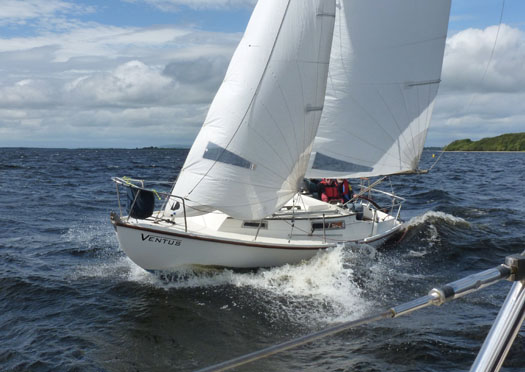
Pat Mahon's Folkboat Ventus (Lough Ree YC) won the cruiser class in the new RIOTI Photo: W M Nixon
Down on the south coast, meanwhile Commodore Cameron Good and his members opened their much improved clubhouse for Kinsale YC nicely in time for the Sovereigns Cup at the end of June, which saw a welcome return of wall-to-wall summer weather and glorious racing for crews many of whom were still licking their wounds from the rugged racing on Tralee Bay. But though it was basically an IRC and ECHO racing festival, it was the gallant veterans of the 1720 Sportsboat class who stole the limelight, with Olympian Peter O'Leary turning in a stellar performance with Spiced Beef to win the overall prize.

Superb racing in the Sovereigns Cup Photo: Bob Bateman
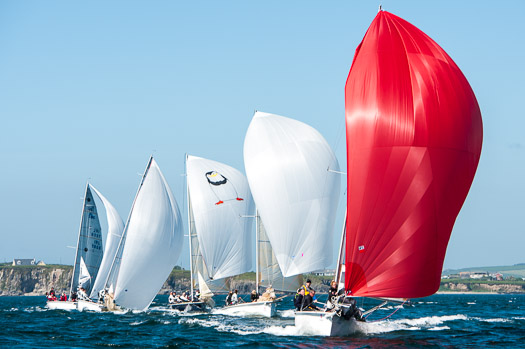
"They haven't gone away you know...." In fact, far from fading away, the Cork 1720s produced the winner of the Sovereign's Cup. Photo: Bob Bateman
July found the summer settling itself in comfortably over Ireland, and entries for the Volvo Dun Laoghaire Regatta accelerated as the dates approached and people realised that this "ultimate suburban sailfest" offered a very convenient opportunity to make hay while the sun shone. Which it did, and big time too, for the entire event. Though some of the 400 or so competing boats (120 of them visiting) might have enjoyed more breeze, skilled race officers used the special effects provided by tides and sea breezes to complete a busy programme for an astonishing total of 13 classes, with Nigel Biggs' classic Rob Humphreys Half Tonner Checkmate XV being best overall with a clean sheet to prepare her for victory in the World Half Ton Classics in France in September.
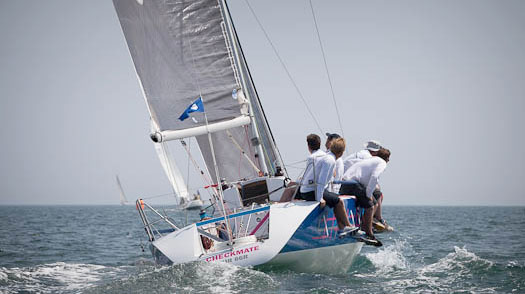
The vintage Half Tonner Checkmate XV (Nigel Biggs) was top scorer in the huge fleet in the Volvo Dun Laoghaire Regatta in July, and then went on to win the Half Ton Classic Worlds. Photo: Aidan Tarbett
VDLR 2013 – OVERALL RESULTS.
IRC CLASS 0 1. Grand Cru II (J McGarry) 2. Zephyr (S Cowie) 3. Dark Angel (A Ackland)
IRC CLASS 1 Bon Exemple (X Yachts GB) 2. Now or Never 3 (N Sandford) 3. Rockabill V (P O'Higgins)
IRC CLASS 2 1. Checkmate XV (N Biggs) 2. Scenario Encore (S&J Fitton) 3. Tribal (L Burke)
IRC CLASS 3 1. Quest (Cunningham & Skerritt) 2. Kilcullen Euro Car Parks (Howth YC K25 Team) 3. Nyah (S Hyde)
J109 1. Joker II (J Maybury) 2. Storm II (P Kelly) 3. Jalapeno (Barrington/ Burke/ Phillips)
SIGMA 33 1. White Mischief (T Goodbody) 2. Leaky Roof (A Harper/ E&K Robertson) 3. Rupert (R&P Lovegrove)
BENETEAU 31.7 1. Levana (J Mitton) 2. Prospect (C Johnston) 3. Levante (M Leahy/ J Power)
IRC Coastal 1. Aquelina (S&J Tyrell) 2. Wow (G Sisk) 3. Mermaid IV (S Fitzpatrick)
NON-SPINNAKER 1 1. Bite the Bullet ( C Bermingham) 2. White Lotus (P Tully) 3. Orna (P Dilworth)
NON- SPINNAKER 2 1. Demelza (S Ennis) 2. Vespucci (S&K O'Regan) 3. Nauti-Gal (J&J Crawford)
Ruffian 23 1. Diane 2 (A Claffey/ C Helme) 2. Ruff Nuff (D Mitchell) 3. Bandit (Kirwan/ Cullen/ Brown)
Shipman 1. Curaglas (J Masterson) 2. Gusto (C Heath/ G Mills) 3. Whiterock (H Robinson)
SB20 1. Should Be? (M O'Connor) 2. BomChickaWahWah (J O' Driscoll) 3. Seriously Bonkers 3 (M Cuppage/ P Lee)
RS ELITE 1. Storm (J Gunning/ S Polly/ D Kelso) 2. Momentary Laps... (J Patterson) 3. Toucan (G&M Vaughan)
BENETEAU FIRST 21 1. Chinook (A Bradley/ P Morgan) 2. Yikes (J Conway) 3. Carna (S Spence)
DRAGON 1. Phantom (P Bowring/ D Williams) 2. Jaguar (M Byrne) 3. Diva (R&R Johnson/ R Goodbody)
Flying Fifteen 1. The Gruffalo (I Matthews) 2. Melliffluence (B Mulligan) 3. The Big Bow Wow (N Meagher/ N Matthews)
GLEN 1. Glenluce (R&D O'Connor) 2. Glendun (B Denham) 3. Glenariff (A Lee)
HOWTH 17 1. Isobel (B&C Turvey) 2. Oona (P Courtney) 3. Pauline (S O' Doherty/ E Ryan)
Fireball 1. Let's Get Messy (B Byrne) 2. Tipsey McStagger (C&J Clancy) 3. Goodness Gracious (L McKenna/ F Rowan)
IDRA 14 1. Starfish (A Carr/ D Kilroy) 2. Delos ii (P O'Neill) 3. Slipstream (J Ascoop/ H Keenan)
MERMAID 1. Tiller Girl (J O'Rourke) 2. Jill (P Smith/ P Mangan) 3. Endeavour (R Bannon)
SQUIB 1. Why not (D Jago) 2. Iola (F Whelan) 3. Perfection (J Fleming)
WATER WAG 1. Mollie (C MacAleavey) 2. Swift (G Kilroy) 3. Pansy (V Delaney)
Sail Fleet J80 Bay Challenge 1. More Mischief (E Doyle) 2. Katie (T Dunne/ F Fahy/ C McGuinness/ D Grace) 3. Xerxes (D O'Neill)
PY 1. IRL 171 426 (F Devlin) 2. IRL Return of the Milky Bar Kid (H Sheehy) 3. UG (R O'Leary)
After this fabulous saltwater festival of racing, the July focus turned to classic boats and then fresh water, with first the Glandore Classics in West Cork, and then the month rounded out with the Mirror Worlds on Lough Derg. The diversity at Glandore was as evident as ever, with the lovely Fife ODs from the Menai Straits making a remarkable impact, but it's in no way a down-grading of the other boats to state that the runaway star of the show was the centenarian Jolie Brise. The famous French-designed and built pilot cutter won the first Fastnet Race in 1925, and she and her crew from Dauntsey's School made a special point of coming to Glandore so that they could have a properly emotional rounding of the famous rock.

The Centenarian pilot cutter Jolie Brise, winner of the first Fastnet Race in 1925, rounds the Fastnet Rock in commemoration during the Glandore Classic Boat Regatta 2013. Photo: Brian Carlin
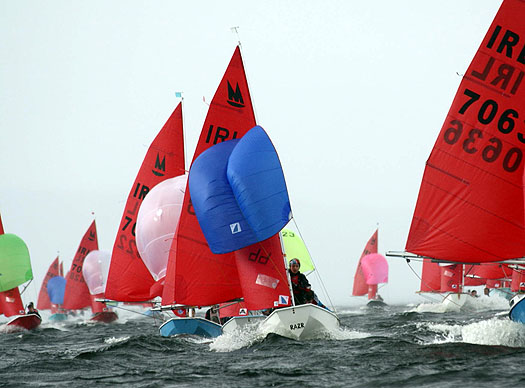
Fabulous sport in an interesting selection of Irish weather – the Mirror Worlds in Lough Derg. Photo: Gerardine Wisdom
As for the Mirror Worlds 2013, what can we say? Everything you've heard about this great event is true. It did indeed muster an international fleet of 93 boats. The hospitality was undoubtedly laid back yet certainly superb. The sailing was Irish sailing at its very best, with Lough Derg in a lively mood. It did indeed go right down to the wire, with the young South African siblings crew of Ryan and Michaela Robinson winning from Ridgely Ballardes and Rommel Chavez from the Philippines. And yes, they did manage to get a senior government minister to perform the official opening ceremony. They pulled off this coup by discovering that Minister for Agriculture and the Marine Simon Coveney harboured a secret ambition to sail a Shannon One Design. The word was he'd do anything, even opening a sailing event on a Sunday evening at some considerable distance from his constituency, just to achieve this. Sailing a Shannon OD at Dromineer on Lough Derg? No problem. The Minister got his SOD sail. The event got its gala opening. And the racing was brilliant.
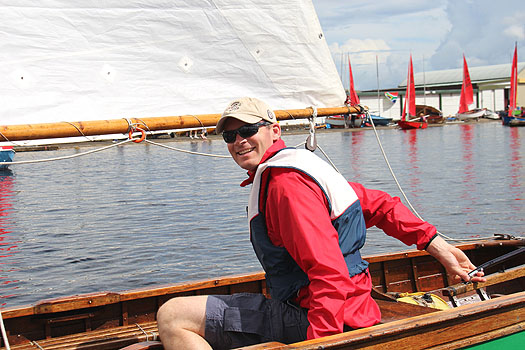
Government minister Simon Coveney achieves his dram of a sail in a Shannon One Design. Photo: Gerardine Wisdom
August is traditional the month for sailing elsewhere. The 81-year-old 17ft Mermaids erupted from their East Coast and Shannon Estuary strongholds upon Galway Bay Sailing Club at the start of August for their week long championship, and it was encouraging that one of the youngest teams – Skerries SC's Mark Boylan crewd by Niall Collins and Aileen Boylan – emerged as winners from a fiercely contested series, with Jim Carthy of Rush second, Paul Smith of RIYC third, and Jonathan O'Rourke (NYC) fourth.
Despite the fact that Dun Laoghaire had two helms in the top four, and the excellent turnout and great Mermaid sport at VDLR when Jonathan O'Rourke had won, the word is that Mermaid turnouts in Dun Laoghaire's regular racing have become so sparse that DBSC won't be providing them with a class in 2014. Perhaps with so much energy being focussed on the Water Wags, glossy Dun Laoghaire only has enough enthusiasm for one traditional clinker-built class.
Meanwhile at other places beyond the seas, August had its time-honoured international biennial festival of the sea, when boats have long since been turned away from a rapidly-filled entry list. 350 of them went off from Cowes in the Fastnet Race on Sunday August 11th, with a goodly Irish contingent among them. But it was very much of the year of the French, with father-and-son crew of Pascal and Alexis Loison on the JPK 1010 Night and Day making history as the first overall winners racing in the two-handed division.
Best of the Irish to win the Gull Salver was Martin Breen's Reflex 38 from Galway Bay SC, which sailed as Discover Ireland under the command of Aodhan Fitzgerald. It tells us everything about how completely international the Fastnet has become by noting that the Galway boat, while 18th overall, was actually fourth overall among boats from Britain and Ireland.

The Galway-based Reflex 38 Discover Ireland was top Irish boat in the Fastnet.
While traditional August regattas proceeded apace at venues on every Irish coast, as the month rolled on the preparations were finalised for major international events in Kinsale, Crosshaven, Dun Laoghaire and Howth. With his election in November 2012 as President of the International Disabled Sailing Association at the ISAF Conference in Dun Laoghaire, John Twomey of Kinsale was soon at work knowing that he could count on his home port to provide the special support for staging the IFDS Worlds, putting in place a programme which came to brilliant fruition in ideal weather
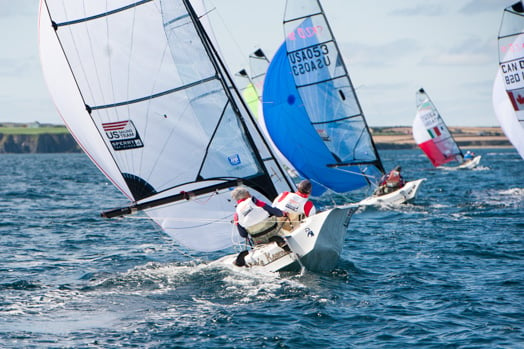
Summertime off Kinsale – racing for the Skud class in the IFDS Worlds 2013. Photo: Bob Bateman
In a good year for global events in Ireland, it was one of the most truly international. The Skud class saw Britain's Alexandra Rickham and Niki Birrell win from Italy's Marco Gualandris and Marta Zanetti, while Canada's John McRoberts was third. In the 2.4s, the winner was the Netherlands' Bijlard Guus, with Germany's Helko Kroger second, France's Damien Sequin third and Australia's Matt Bugg fourth in the numerically strongest fleet – forty-five 2.4s sailing out on the blue Kinsale sea. And in the Sonar, where in times past John Twomey has himself been among the medals, the winner was France's Bruno Jourden with The Netherlands' Udo Hessels second and Australia's Colin Harrison third, while John Twomey was best of the Irish at ninth – crewed by Anthony Hegarty and Ian Costelloe – in a fleet of 18 boats.
Round on the east coast at Howth, a lengthy buildup to the BMW J/24 Worlds 2013 had seen some locals take on board the suggestion that a very reasonably priced second hand market means these iconic little sloops could be acquired for a small layout. And then with elbow grease and sailing determination, you could be in the hunt at world level in a class which prides itself on its economical approach to top class sport.
Well, as the fleet gathered, it soon became obvious that some nations' versions of "economical approach" is another nation's notion of stratospheric expenditure. Ironically, however, in view of who is currently at the top of Europe's economic tree and who is towards the bottom, the impoverished Irish found themselves most at one with the German contingent. Germany will be hosting the J/24 Worlds in a couple of years times, so three young German crews turned up with their boats in Howth to test the water. And far from renting luxury waterfront houses as accommodation for the duration of the championship, all they wanted was somewhere to pitch their old bell tents.

The J/24 Worlds 2013 at Howth – who would think this photo was taken less than ten miles from Dublin city centre? Photo: David Branigan
The word from J/24 International is that Irish race officers are held in high regard, and David Lovegrove's performance at Howth through an extraordinary variety of weather further reinforced this view. Despite losing one day completely to calms, he put through the full programme, the racing was marvellous, and the US crews were in top form, though at least the winner, Tim Healy of Newport RI, was clearly an American of Irish descent. Defending champion Mauricio Santa Cruz of Brazil was second, while another US helm, Travis Odenbach from Rochester NY was third, having fallen from the grace of overall lead on the final day. And with the last race won by Germany's Tobias Feuerherd, who knows but success for the worlds in 2015 in Germany may already be a-building for the home team.
As for other classes in late August and early September, it was the ever-young Laser all the way in both Cork Harbour and Dublin Bay. The Vodafone Laser Nationals at the Royal Cork from August 22nd to 26th produced a very healthy spread of results in the Standard Rig division, with Chris Penney of East Antrim winning from Alan Ruigrok of Rush, while Russian visitor Maxim Nikolaev was third and Philip Doran of Courtown took fourth.

Gold Medallist. Annalise Murphy is borne ashore after her mighty win.
The Laser parade then moved on to Dublin Bay, and shifted up several gears to become the Europeans hosted by the National YC. While the Men's Standard Class was limited to 120 boats, with all the different divisions afloat the fleet total was pushing towards the 340 mark, an exercise in logistics which is almost beyond comprehension. Fortunately, some good Irish results brought clarity, with Annalise Murphy triumphing to win Gold in the Women's Radials, while 17-year-old Finn Lynch won Gold in the Under 21s, Silver in the Europeans, and Bronze in the Men's Radials.
This youthful achievement in September was boosted at the end of the month in Germany on Lake Constance, where the Irish Team in the European Under-23 Match Race Final was skippered by Philip Bendon of Baltimore to the Gold Medal. His crew were James Bendon, Christopher Tiernan and Bruno van Dyke, and their good showing kept British skipper Mark Lees back in second, while the Italian crew took the bronze.
Moving into October, Irish prospects for the Student Yachting Worlds were beginning to look a bit flaky. The French hosts had greatly tightened the format, moving the event to the no-nonsense venue of Pornic in Brittany, and down-sizing the boats to J/80s. Theoretically this should have favoured the two-pronged Irish campaign, as the SailFleet J/80s were readily available for intense training, but the economic realities of discerning post-college career paths poutweoighed the attractions of endless sailing opportunities, and by August it was clear that University of Limerick would not be availing of their right to be the Irish challengers, while defenders University College Dublin had seen changes in personnel such that they had little enough in the way of crew battle-hardened by previous SYWs.
Nevertheless the UCD crew, with Philip Doran as helm, gave it their best shot, while Dublin City University, as runners-up in the selection trials, took over the Limerick place at short notice and under skipper Ryan Scott, they assembled a crew entirely from the junior membership of Howth YC. Out of fifteen teams, with the French very much in control to win overall with Switzerland second and the US third, the Irish had to be happy with 8th and 9th, while the "Howth nippers" drew some additionl concolation from the news that clubmate Laura Dillon had skippered the winning team in the British Women's Open Match Racing Championship.
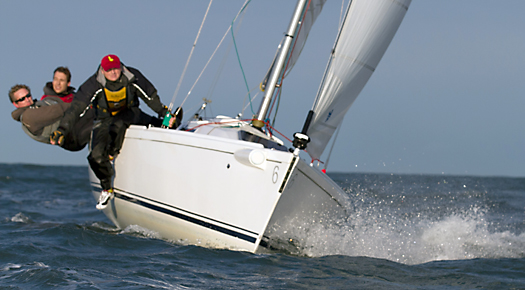
Ben Duncan on his way to winning the all-Ireland. Photo: Aidan Tarbett
October saw select keelboat classes descend on Lough Derg for their traditional Autumn Regatta at Dromineer, and further lustre added to the achievements of Irish SB20 champion Ben Duncan, who had a runaway win in a class which has revived itself in Ireland with a bootstraps operation during 2013. He then went on to win the Helmsmans Championshjp raced in the SailFleet J/80s in Howth at the end of October. The weather was going haywire with the buildup to the St Jude's Day storm, so it reflects all credit on both participants and the race management team that a full programme was put through in just one day, with a break in the middle to allow a vicious little front to go through. In fact, the race officer worked the weather window so well that all the photos seem to show glorious perfect sunny sailing. Seafra Guilfoyle of Royal Cork was runner up, with FF Champion Ian Mathews of the National third.
The Autumn saw the focus shifting towards the Mediterranean, and it brought success for Cork's David Kenefick in the Figaro Solo Circus. After various ups and down throughout the season in Atlantic waters, the Mediterranean Autumn programme saw it go down to the wire for the coveted Rookie of the Year title, and the final races saw everything go Kenefick's way to be the first Irish winner.
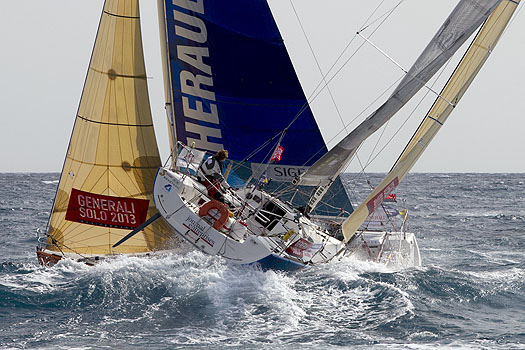
David Kenefick was Rookie of the Year in the 2013 Figaro Solo programme.
In recent years there has been Irish success in the Middle Sea Race out of Malta in late October-early November in the two-handed division, but for 2013's race a couple of the leading Irish two-handed teams threw in their lot with the fully-crewed Maltese-owned J/122 Otra Vez. It was a shrewd career move. They won Class 4, and placed 11th overall in a fleet of 97 boats. Next best of Irish interest was Dermot Cronin's First 40.7 Encore from Malahide, which finished exactly at mid-fleet.
Into November, and interest moves even further southward and even warmer, with the 360-mile Duba to Muscat Race. Adrian Lee's Cookson 50 Lee Overlay Partners, overall winner of the first RORC Caribbean 600 Race in 2009, and overall winner (as Ger O'Rourke's Chieftain) of the 2007 Fastnet, goes into the Muscat race as favourite, and doesn't disappoint, with a new course record too.
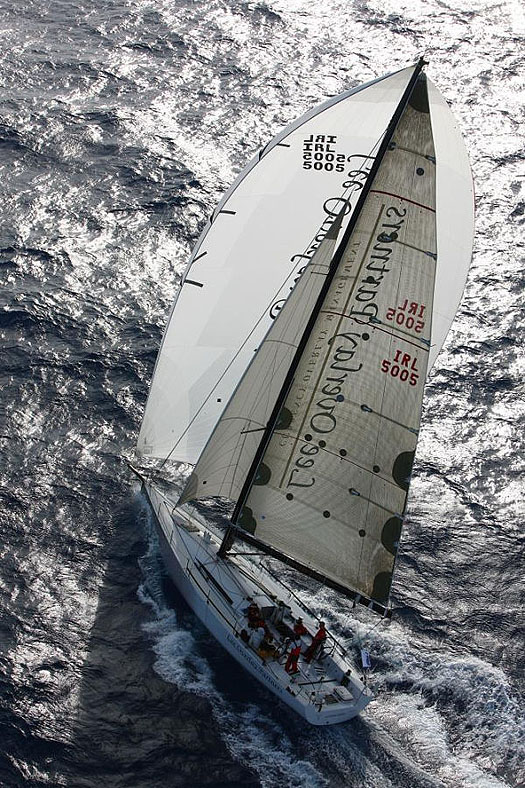
Adrian Lee's Cookson 50 Lee Overlay Partners on her way to comprehensive victory in the Dubai-Muscat Race. Photo: Tim Wright
And meanwhile out in Australia, a new Dubai-built 60ft Ichi Ban for legendary owner Matt Allen is emerging in preparation for the Sydney-Hobart 2013, starting December 26th. Among the team involved in this ultimate racing machine is Gordon Maguire. Which seems to be where we came in...
For more on 2013's Irish sailing highlights read Afloat's Sailor of the Month Awards
New Sailing Tracker App 'Will Save Many Lives'
#Apps - A new smartphone app developed by the Irish Sailing Association (ISA) that aims to make it easy for boaters to allow contacts on shore to monitor their voyages has been launched today (Thursday 22 August).
Marine Minister Simon Coveney was on hand in Cork for the official unveiling of ISA SafeTrx, which was developed in association with the Irish Coast Guard and DeCare Systems Ireland.
The SafeTrx app is available free for iOS and Android powered smartphones and tablets, and lets boat owners log their voyages directly into their device - allowing them to be tracked by their chosen contacts, including the Irish Coast Guard.
It's also expected that the app will also help the coastguard to identify the location of a stricken vessel, and assess details such as craft description, contact details ashore, previous activity, where the boat was last visible to the network and where headed, persons on board and other information - all targeted at reducing the time that seafarers spend in the water waiting for a lifeboat or helicopter.
“SafeTrx helps take the search out of search and rescue," said Irish Coast Guard director Chris Reynolds. "It encourages all sea users to plan and execute their trips better, safer and gives assurance to friends and partners ashore.”
His comments were echoed by ISA chief executive Harry Hermon, who said: "I believe that ISA SafeTrx, which has been designed by coastguard professionals and built right here in Cork, will help to reduce the number of fatalities on the water even further. I have no doubt that this will save many lives."
Also speaking at the launch today, Minister Coveney said: “The concept of safety at sea and on our network of rivers and lakes must become as commonplace as that of safety on our roads. We need to create a culture of safety first for those travelling on our waters for either commercial or recreational reasons.
"With loss of life continuing across the maritime spectrum, those who make their living from the sea and those who utilise the sea primarily for leisure purposes must ensure that safety becomes a top priority.”
ISA SafeTrx logs position reports every kilometre (or every 5 minutes if stationary). Should the user fail to return on time, their emergency contacts will be automatically alerted via SMS and advised to initiate the appropriate action.
Voyage position reports are displayed on the SafeTrx Monitoring Console so when an emergency contact calls the Irish Coast Guard concerning an overdue trip, coastguard staff will have access to the user’s location and SafeTrx trip data through a secure SafeTrx server. And as the ISA SafeTrx app periodically sends location data back to the servers, the coastguard's response team can get help directly and quickly.
However, an expert in GPS technology has warned boat users against relying solely on such apps when heading out on the water.
Writing for Afloat.ie's Have Your Say blog, Gary Delaney of Global Position Intelligence (GPI) says the GSM and GPRS location technology on which the SafeTrx app is based is "less than reliable" in Irish coastal and nearshore waters, and "can deteriorate with the weather".
"It is well recognised that in the event of a maritime emergency, lifesaving agencies need to know the current position of the casualty as quickly as possible," he writes. "An assessment of available technologies reveals that only normally approved safety communications devices, such as marine VHF, AIS, EPIRBs, PLBs, ELT, etc can come near guaranteeing that requirement."
The app developers have acknowledged such concerns, saying that ISA SafeTrx is "not intended to be used as a replacement for statutorily recognised safety devices" but is "a resource that in some instances may help to raise an alarm earlier and assist emergency services to locate casualties more accurately".
As always, Afloat.ie advises boaters and sailors to stick to a standard safety checklist, which includes informing a contact on shore of your plans and expected return time, and confirming that you have adequate means for calling for help - from a suitable VHF radio to flares for signalling distress.
New Sailing App Calls For Note of Caution
In our latest Have Your Say contribution, Gary Delaney of Global Position Intelligence (GPI) expresses his concerns about the new ISA sailing app and how it might encourage boat users to be less prepared on the water
With regard to the recent marketing for the new ISA SafeTrx smartphone app, I wish to add a note of caution to those who might consider using it.
Whilst it may well be very useful as a passage plan filing tool, the element of the app which concerns itself with tracking a vessel should NOT be relied upon as it depends solely on mobile phone coverage.
It is widely known that the mobile phone coverage in Irish coastal and nearshore waters is less than reliable (and can deteriorate with the weather) and international maritime safety organisations routinely warn against reliance on mobile phones for communications in those areas.
I am sure that the Irish Coast Guard had originally intended that warnings would be associated with the marketing of the app for this purpose, but the nature of apps and social media is such that they are normally not used for promoting safety critical solutions, and therefore warnings may be getting lost in the promulgation.
In short, neither smartphones nor the GSM/GPRS network that supports them are reliable for any aspect of maritime safety, and there are more suitable technologies already available for the purpose.
As international maritime safety organisations do not normally recommend the use of mobile phone technology for any aspect of marine safety, the Irish Coast Guard must have significant justifications for deviating from this long established policy, and it would be useful if these were stated.
Similarly, it would also be useful to know if this initiative is being supported by the Irish Marine Safety Working Group in the Department of Transport, which has responsibility in this area.
It is well recognised that in the event of a maritime emergency, lifesaving agencies need to know the current position of the casualty as quickly as possible. An assessment of available technologies reveals that only normally approved safety communications devices, such as marine VHF, AIS, EPIRBs, PLBs, ELT, etc can come near guaranteeing that requirement.
These devices have gone through years of global development, advancement, testing and approvals for the purpose in a marine environment and, therefore, only these can be relied upon to minimise the 'search' element of the 'search and rescue' effort – and thereby give casualties the best chance of survival.
Whilst the ISA SafeTrx app may be aimed at those who under current legislation are not required to carry any of the approved devices, I feel that life saving agencies are better served by raising awareness about what is approved and encouraging water users to use them voluntarily anyhow, rather than confusing the message by emphasising the 'tracking' element of the app.
The fact that the app is free (airtime costs excluded), and the approved technologies are not (though very affordable, especially when personal safety is the prize), further confuses the message.
And the RNLI, who have been rescuing people on our coastline for hundreds of years, are very clear that marine VHF is to be preferred over mobile phones in all cases (their website confirms this).
There has been much poorly informed comment in popular media about the SafeTrx app. One comment alleges that the app is particularly suited to "weekend and leisure crews who may prefer more accessible and less sophisticated communication equipment".
But it is not about what is 'preferred', and this and other similar comments are misleading and potentially dangerous, The Irish Coast Guard and the Irish Sailing Association should consider taking action to correct them and ensure suitable warnings are publicly communicated wherever the app is being promoted.
To the best of my knowledge, the Irish Coast Guard has no role in the development, testing or approval of marine safety equipment. Therefore, whatever investment or effort has gone into supporting this app may well have been better spent serving the coastguard's role of raising public awareness around the availability and use of approved marine safety equipment, including the radio and communications devices that are available for use in Irish waters – most likely in co-operation with its other partner agencies in the Irish Marine Safety Working Group.
For my own part, I strongly suggest that water users in coastal areas would use common sense when it comes to their personal safety by investing in approved technologies whether they have to or not and get themselves properly trained to use them.
If using the SafeTrx App, then do so with considerable caution – only as an addition to the approved devices, and then primarily just for filing passage plans.
Big Decline In Shannon Passages Over Last 10 Years
#Shannon - Passages on the River Shannon in 2013 so far have fallen more than 50% compared to numbers for the same period a decade ago, according to the Irish Waterways History blog written by Afloat's inland correspondent, Brian Goggin.
Using statistics supplied by Waterways Ireland, the site plotted a graph that shows an overall decline in lock and bridge passages on the Shannon in the months from January to May each year since 2003, with a slight spike in 2007 the only buck in the downward trend.
Though the figures do not record all uses of the waterway (such as sailing, angling and other watersports) and do not account for variables such as the weather, they are indicative - the site claims - of "the Shannon's most significant tourism activity, the cruiser hire business".
Indeed, the figures apparently show that boat hire passage numbers have fallen from 11,440 in January-May 2003 to just 4,781 in the same months this year.
Even private boat passages have been falling from a peak in 2009 to just below their 2003 numbers, if the site's interpretation of the stats is anything to go by.
However, a source close to Afloat.ie says that the falling numbers may be skewed by a growing emphasis on larger-capacity vessels on Ireland's inland waterways, with eight- and 12-berth boats supplanting older four-berth vessels, and families and groups consolidating their recreational boating.
It will be interesting to see how the rest of the year turns out, and whether the overall numbers from January to December will tell a different story of the state of the Shannon and other waterways.
New Smartphone Apps For Smart Sailing
#SailingApps - Two new smartphone apps are just the ticket for anyone looking for an easy-to-use reference guide while out on the water as this summer's sailing season gets into full swing.
Safe Skipper - for iOS and Android devices priced €2.69 (with a free version also available) - touts itself as an "essential quick reference" app intended for everyone who goes to sea, whether sailing or in powerboats.
The app is divided into three main sections. The 'preparation' section includes details and tips on doing engine and rigging checks, overboard drills and weather and tidal updates. The 'safety' section covers necessary equipment from anchors to flotation aids, and communications guides on AIS, VHF radio and even Morse code.
Finally, the 'distress and emergencies' section details plans of action in the event of dismasting, engine failure or fire, medical emergencies and abandoning ship.
Safe Skipper is illustrated by RYA qualified yachtsman Simon Jollands, providing clear instructions for whatever issue you might have while afloat.
Meanwhile, SailingApp (for iPhone, priced €5.49) is "built from the water up for sailors by sailors".
The dual-function app is split between tools - allowing sailors to make on-the-fly calculations and checks for such things as anchor rode - and topics essential for good seamanship practices available with a single click.
Users who download SailingApp before 31 May will also receive any future updates to the app free of charge.
RS400, RS200 & RS Feva 2013 Royal St George Easterns
The three RS classes battled it out last weekend at the Seapoint end of Dublin Bay for the season's first event, the Eastern Championships. The event attracted a total entry of thirty five boats with nineteen RS400's, eleven RS200's and six Fevas.
Full results are available to download as a pdf file below
Race Officer Barry Mac Neaney assisted by Jimmy Murphy and his crew on the committee boat "Lady Beag" from Poolbeg Yacht Club did a fantastic job to promptly fire off four races on Saturday in shifty and testing conditions with strong tides added in for good measure. The final two races were sailed in stronger gusty conditions on Sunday, which proved a stern but exciting test for all crews.
In the RS400 class there was a three-way tussle at the top between Bob Espey & Michael Gunning of Ballyholme YC/Royal Ulster YC, Emmet & James Ryan of The Royal St George YC and Mike "Chunky" Ferguson & Jeremy Tomalin of Ballyholme YC/Royal Ulster YC. The three boats appeared to be tied together by a piece of string for much of Saturday's four races with only a two point gap separating first and third overnight.
In Sunday's first race for the 400's a slight miscount of laps by the majority of the fleet left the top two of Bob Espey/Michael Gunning and Emmet/James Ryan to fight it out in a match race which left both on equal points for the final race. Bob and Mike took the final race in strengthening wind conditions and with it the RS400 Easterns.
In the RS200's it was local class newcomers Conor Totterdell & Myles Kelly who topped the fleet taking both the overall and junior trophies. This was a great achievement in a range of trying conditions. Conor & Myles are sure to be a force to be reckoned with this season, particularly with the Dún Laoghaire RS fleet growing in numbers and talent. Second in the RS200's was Newcastle YC's Clive Coffey & Helen Cassidy. The 2012 Traveller Series

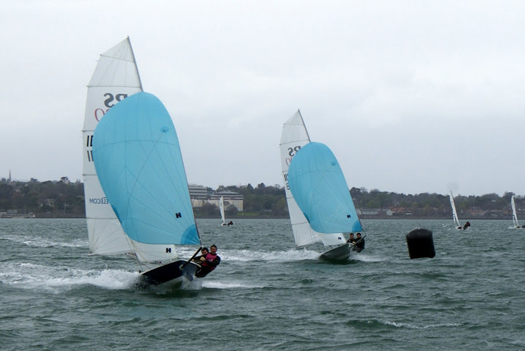
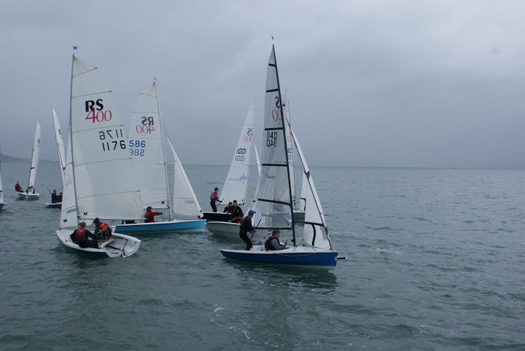
RS action at the Eastern Championships on Dublin Bay. Photos Sean Cleary
Champions from Newcastle once again proved ever consistent performers over the weekend. In third place and taking over the helm form his Dad Sean for the first time was Stephen Craig and his crew Conor Foley. Stephen & Conor had an unfortunate last race which in the end cost them the event. No doubt they will be back fighting for top spot at the next RS event in Greystones on the 22th of June.
The Feva class benefitted from on the water coaching throughout the event and this definitely helped to iron out any early season creases by the end of the six races. Jack & Henry Higgins grew massively in confidence over the series and counted three bullets from the last three races. Emer Rafferty & Laura Coleman gave the Higgins brothers a great run for their money and finished just one point off top spot. Dara Donnelly & Rosemary Tyrrell put in a very solid six races to finish up in third place.
Top 3 RS400's
Place Helm Crew R1 R2 R3 R4 R5 R6 Total
1st Bob Espey Mike Gunning 1 3 2 1 2 1 7
2nd Emmet Ryan James Ryan 2 1 3 2 1 3 9
3rd Mike Ferguson Jeremy Tomalin 5 2 1 3 DNF 2 13
Top 3 RS200's
Place Helm Crew R1 R2 R3 R4 R5 R6 Total
1st Conor Totterdell Myles Kelly 2 1 2 2 3 6 10
2nd Clive Coffey Helen Cassidy 3 4 1 3 5 2 13
3rd Stephen Craig Conor Foley 4 3 3 1 2 7 13
Top 3 RS Feva's
Place Helm Crew R1 R2 R3 R4 R5 R6 Total
1st Jack Higgins Henry Higgins 4 5 2 1 1 1 9
2nd Emer Rafferty Laura Coleman 1 3 1 3 2 4 10
3rd Dara Donnelly Rosemary Tyrrell 3 4 3 2 4 2 14
Claudine Murphy & Andrea Brewster. 49er FX Skiff Campaigners
Annalise Murphy's older sister Claudine has announced plans to join Annalise on Rio's Guanabara Bay in the latest Irish women's skiff campaign.
Claudine has teamed up with former British trialist Andrea Brewster in a bid for the Irish 49erfx slot against Tiffany Brien and Saskia Tidey also seeking a place in the official squad and a place in this new class for the Rio games.
Here Claudine gives some background on her campaign:
I met Andrea for the first time at the 2004 Laser Radial Europeans in Bangor. Andrea has been sailing the laser full time since then and was Annalise's training partner for the London Games. Annalise had joked about us teaming up in the FX for 2016 but we did not look into it seriously until February of this year. Andrea has dual citizenship so decided to use this to team up with me and start a campaign. She has been in the top 30 in the world consistently from 2005 to 2012 in the laser radial, her most notable result being a bronze medal at the 2008 Laser Radial Worlds. We both decided we had similar ambitions in our sailing and are at a position to go full time to give it a proper go.
We intend on debuting at Sail for Gold in Weymouth where we have been training for the past five weeks. Portland harbour is ideal for learning how to skiff sail as it is large and relatively obstacle free! We then plan on attending the next European cup event in Kiel followed by the Europeans in Denmark. There is then quite a large gap until the worlds in Marseille in mid September.
Our short term goals are to make ISC funding so we can progress forward into 2014 with support. Our main goal for now is to learn to control the boat in all conditions. Skiff sailing in a breeze is more extreme than any kiteboarding or skiing I have done in my last year of travelling! We have had some very comical scenarios in this learning process which makes the terror and injuries sustained worthwhile! I am also very glad of the fitness I worked on last year when I rowed for DULBC while doing my Masters in Trinity. Skiff crewing is very physical so my fitness regime has increased dramatically in the past few months. Long term it will be important to qualify the nation in Santandar next September as it will be much more difficult to do so with the new continent divisions in nation places for 2016.
I think the difficult thing about sailing a double handed boat is finding somebody you can have a successful working partnership with. But I am delighted to have found somebody to sail with who is so talented and dedicated to Olympic sailing as Andrea is. We are basing ourselves in DunLaoghaire from now so between ourselves and Annalise in her moth we will give the pier onlookers lots of entertainment this summer!
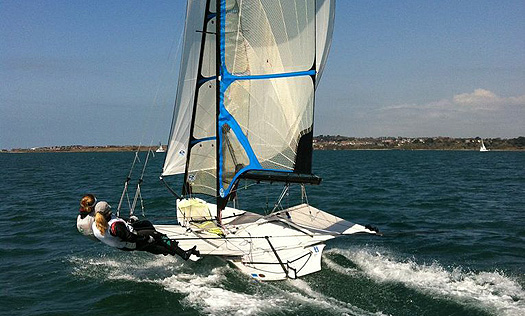
Claudine and Andrea in flying form in a training session in Weymouth. Photo:Tom Peel
Below Andrea also gives some background to the new campaign:
Towards the end of last year I made the decision to sail the 49erFX which is the new Women's Skiff Class in for Rio 2016. The FX is by far the most exciting class ever to be brought in for Women to sail at the Olympics and I could not resist the opportunity to sail full time in such a fantastic boat. So I bought an FX and with the help of some good friends I began learning to try and master the art of skiff sailing.
The difficulty I have found about learning to sail the FX is that as a beginner its fairly risky to go sailing in anything much above 15 knots so that immediately reduced the amount of days I was able to train. Between October and March I think I managed to do about 3 weeks of sailing in total as either there was too much wind or I was unable to find anyone to sail with. I started looking for someone to team up with to get a campaign underway back in September and despite trying out with some very good sailors I was unable to find anyone in a position to be able to sail full time with me. After such a slow start and still no full time crew I was beginning to wonder if I was realistically going to be able to continue campaigning. I thought back to conversations I'd had with my great friend and training partner for the last few years in the Radial, Annalise Murphy from Ireland. We used to joke that I should become Irish and sail a skiff with Annalise's sister Claudine for 2016. At the time it sounded pretty far fetched but nearly 6 months after buying my FX and no further on with a campaign I realised that this might be the only opportunity I might have. My Mum's side of the family are all of Irish descent, so I knew that I could be eligible to sail for Ireland. After talking it through with Claudine and discovering that she was also at a cross roads in life which meant she could go full time if sailing if she wanted, we decided to try out together in the FX. We discussed things in great detail and I was pleased to learn that we both shared the same aspirations for the campaign and from there we decided to seize the opportunity and go for it!
So I am now pleased to officially announce that Claudine Murphy and I are campaigning for Rio 2016 sailing for Ireland. We are only a few weeks into our training so far but as you can see from the picture we are throwing ourselves into it!
I am very grateful for all the support and encouragement I have received so far from everyone about my decision to switch to sail for Ireland. I have many fond and proud memories of my time representing Britain and I am now looking forward to this next exciting chapter in my life!
Irish Trad Boat Leader is Veteran of Gaffer Global Circuit
#vintage boats – The season-long Golden Jubilee cruise of the Old Gaffers Association starts to roll this weekend, with vintage boats from the Thames Estuary setting out tomorrow to rendezvous in the Orwell estuary in Suffolk with character boats already on their way from Holland. And when the growing fleet reaches Dublin Bay for major events between May 31st and June 4th, they'll find the welcoming party is headed by a sailor who has been round the world under gaff rig.
The Old Gaffers Association was barely a year old when the current President of the Dublin Bay branch set out on a global circumnavigation under traditional rig in an already famous classic ketch, a vessel whose status was to become almost legendary when this voyage was completed.
It was the morning of Sunday 21st February 1965 when the 47ft Sandefjord slipped her lines from a quayside packed with friends and well-wishers in Durban, South Africa, and headed seaward down the harbour with an accompanying fleet. Instantly into open ocean at the pierheads, she was soon heading west for Cape Town, reeling off the miles on a close reach as her goodwill flotilla peeled off one by one to head back to the shelter of the great port. Sandefjord was now alone on the high seas
But the friends and supporters were to be out there again in increased numbers two years later to greet her when she returned from the eastward, with 30,729 miles completed in a classic global circumnavigation which had gone on from Cape Town through the South Atlantic to the Caribbean, thence to the Panama Canal and on to the Galapagos, then on across the wide blue waters of the Pacific to Polynesia and eventually to Sydney in Australia. From there it was northwards, cruising through the Great Barrier Reef and on into the Indian Ocean, then southwestward on the final long transoceanic leg, back to a rapturous welcome in Durban.

Tim Magennis in 1965 after he'd joined Sandefjord's crew
It is Tim Magennis, longtime member of the Dublin Bay OGA and its current President, who gives us the direct link to this fine voyage. With a boyhood in the coastal village of Ardglass in County Down, most of his early seagoing experience was with summer jaunts on one of the local fishing boats. But having shown a youthful a talent for journalism, he went straight into it from school, soon finding his way to national newspapers in Dublin.
From there, he went on to work in newspapers in Africa in the late 1950s, and by the early 1960s found himself on the staff of the largest daily in Durban. Always drawn to the sea, he was fascinated by Durban's port, the largest in South Africa. Yet despite its size he noted that his paper gave port matters no prominence whatever. When he pointed this out to the editor, Tim was promptly detailed off to write a regular column about maritime affairs. Hanging out on the waterfront became part of his job.
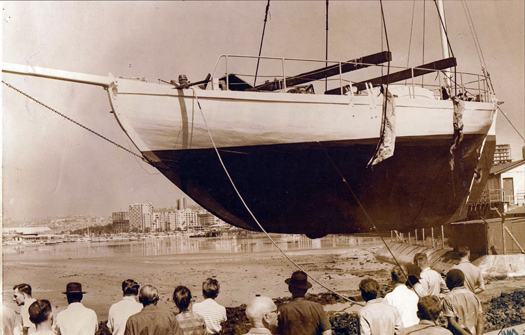
Sandefjord being craned in after her restoration in 1964-65
Through this, he met up with the people restoring Sandefjord, a classic former Redningskoite designed by Colin Archer (1832-1921), Number 28 constructed in 1913 by Jens Olson at Risor Batbyggeri. She was one of the last of the type specifically for rescue work to be built to the designs of the famous Scottish-descended Norwegian naval architect, who had also designed and built Erskine and Molly Childers Asgard in 1905. Although motor-powered lifeboats had been about since G L Watson pioneered the first one for the RNLI in 1904, sail and oar continued to play a prominent role in many rescue services, and the exclusively sail-powered Sandefjord accompanied the Norwegian fishing fleet from 1913 to 1934.
Stood down from rescue duties after 21 years of gallant service, in 1935 she was bought by noted Norwegian ocean voyager Erling Tambs, who wanted to provide a Norwegian presence in the forthcoming Transatlantic Race from Newport, RI to Bergen. Crossing the Atlantic westward in May 1935, Sandefjord was pitch-poled with the loss of one crewmember. But Tambs and his remaining shipmates still managed to nurse her to Newport, where they sorted the damage, and then raced back across the Atlantic.
In 1939, with World War II imminent, Tambs sailed her out to South Africa, where she was sold to Tilly Penso of the Royal Cape YC, who kept her with loving care for twenty years. She became a cherished part of the Cape Town sailing scene, with her rig simplified for family sailing by conversion to Bermudan ketch.
With Tilly Penso's death in 1959, she was sold by his estate, and went through a quick succession of owners. Though her gaff rig was restored, she was slowly going downhill, and by 1962 was more or less abandoned in Durban. There, already on the slide to becoming a rotting hulk, she was spotted by a restless young South African of Irish descent, Patrick Cullen (23), who despite having a very young family, had notions of a seagoing adventure. His brother Barry (24) was a qualified master mariner, and the two of them saw the potential in Sandefjord.
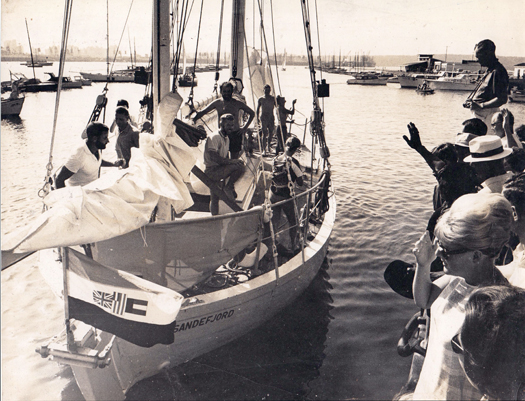
Slipping the lines - departure from the Durban quayside
The notion of a two year voyage round the world to the romantic South Seas took shape, with a proper film being made of it to make their fortunes afterwards. They managed to buy Sandefjord with the support of their mother in 1963, and secured a place on the Durban waterfront for a restoration project which soon became almost a re-build. But these were two very determined young men, and soon they were attracting like-minded spirits to join their project. It was all done in a very businesslike way, with crewmembers being required to sign a clearcut contract and commit one thousand rands up front towards the expenses of the voyage.
It was in those heady days of hard preparatory work and boundless horizons that the recently-appointed Durban maritime correspondent met up with them. At 32, Tim Magennis may have been a few years older than the next oldest member of Sandefjord's crew, but he always seemed much younger than his years - he still does at 81 – and within days he was being swept up with shared enthusiasm. He jacked in his dream job, though agreeing to file reports from around the world and write up the story for the paper on their return, and signed on as the final member of Sandfjord's crew of six, throwing himself into the final frantic months of preparing the ship for the great voyage.
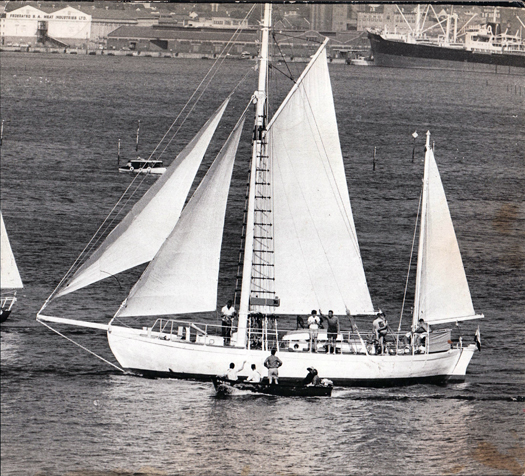
Getting under way from Durban

The departure from Cape Town had a fleet of well-wishers which included two boats of the Royal Cape OD class (see Sailing on Saturday 02/02/13)
It was a classic cruise, all the better for being at a time before sailing became overly regulated and monitored. Thus although they'd a painfully slow passage from Panama out to the Galapagos, at one stage taking an entire week to make good one hundred miles, once they got to those extraordinary islands they were able to cruise among them with a freedom denied in today's heavily regulated environmental protection of that unique place.
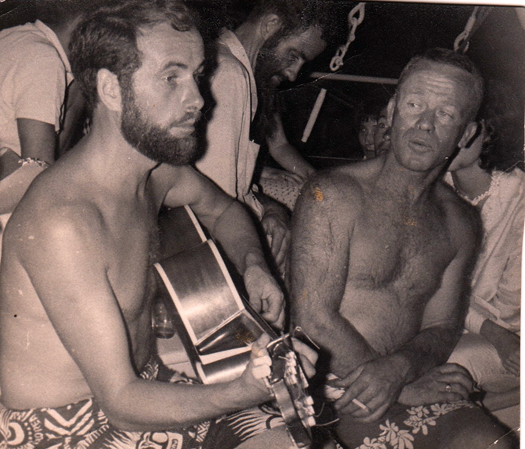
The President of the DBOGA in his days as an ocean busker – Tim Magennis with his guitar in the South Seas aboard Sandefjord.
Tahiti was still a place of romance before mass tourism made it blasé, and among the Pacific islands Tim's talents with the guitar were much in demand. But they surely paid for their lotus eating in the South Seas. The passage on to Sydney, far from being tradewind bliss in southeasterlies, became a slog almost all the way against unseasonal headwinds which culminated in yet another gale on the final night at sea. It brought down the mizzen mast around their ears, and there was a fierce struggle to secure the broken spar on deck.
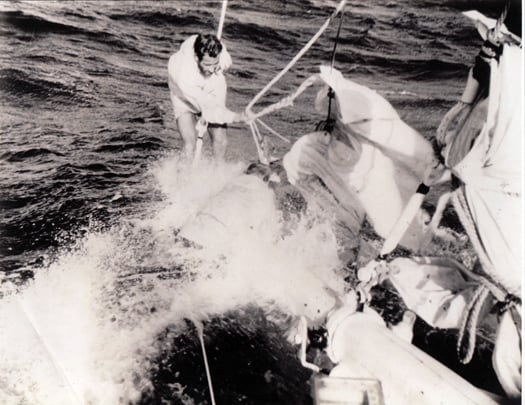
Bowsprit work in the open ocean
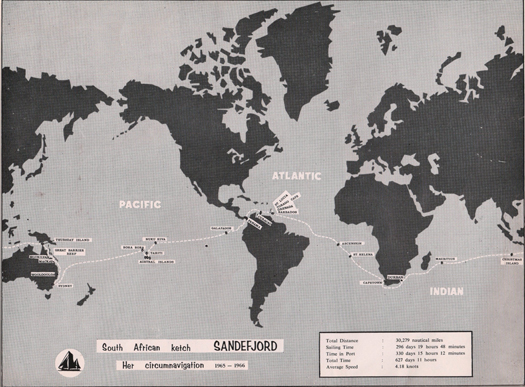
So who needs Europe? Sandefjord's circumnavigation of 1965-67

Sandefjord living the South Seas dream
But when they finally arrived exhausted and battered at the Cruising Yacht Club of Australia in Rushcutters Bay, they'd come to the right place. After taking 50 days for a passage which should have taken only about 33, with stores down to just 20 cans of baked beans, they were distinctly peckish. However, lunch on arrival at the CYCA was just the job, with enormous steaks. Tim is slim now, as he was then. Yet like the rest of the crew, having enjoyed one enormous Australian lunch, he simply sat on and ate his way right through a second one, with all the trimmings.
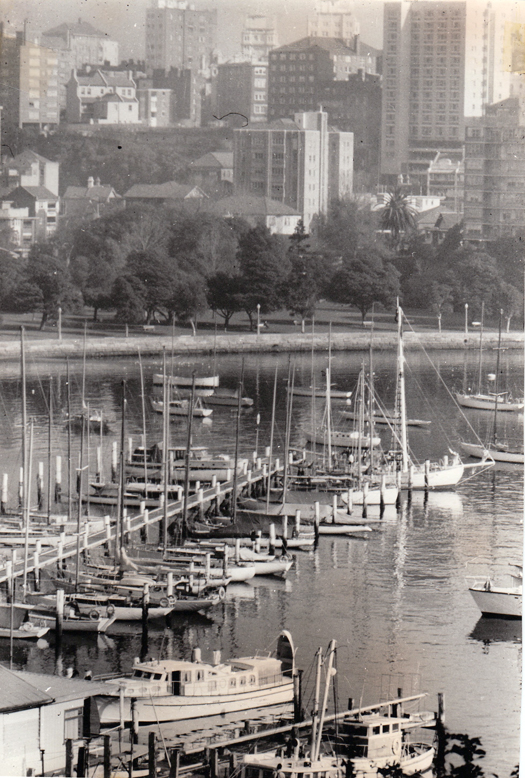
Urban paradise – the CYCA provided a haven for recuperation and repair in Sydney, with Sandefjord's mizzen re-rigged after breaking on the last night at sea
They gave a boat a complete refit at Sydney, glued and fastened the saved mizzen mast, and then headed on north for the Great Barrier reef. But inevitably at this final stage of the voyage, resources were becoming stretched, so when the gearbox on their Perkins diesel gave up the ghost, they sold the otherwise sound engine for 400 much-needed Australian dollars at Thursday Island and completed the rest of the voyage, along the north coast of Australia, across the Indian Ocean and home, under sail only.

A little bit of fund-raising with the sale of the engine at Thursday Island
Their average speed for the entire cruise was 4.18 knots, but when you see the one hour and 54 minute film – which has recently been re-mastered and is well worth viewing for this glimpse of life when the world was a simpler place – you soon realize that with half a decent breeze, the handsome Sandefjord could trot along in some style. And for her young crew, it was simply the time of their lives.
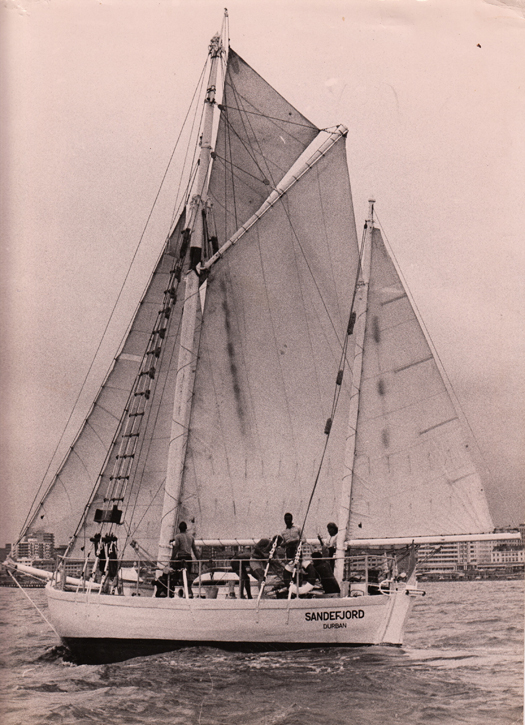
The triumphant return. Her sails may be showing evidence of hard work, but Sandfjord arrived back in Durban in fine shape.
Back in Durban, reality intervened. Tim found himself locked into a hotel room until he completed the account of the voyage for his newspaper. Then a message from home from an older brother, an officer in the Irish army, was a three line whip – he was to get back to Ireland soonest for their parents' Golden Wedding anniversary.
He returned to an Ireland considerably changed. In the late 1960s, the place was finding new and very welcome vitality. He never returned to Durban, but married Ann and settled in Dun Laoghaire on the shores of Dublin Bay, perfectly fitting his new job as PR for the Irish Tourist Board. He became a voice for Ireland. You could always be sure that the usually gruff William Hardcastle of the BBC's World at One would have a smile in his voice after chatting on the air with Tim Magennis about something of interest in Ireland.
As for Sandefjord, Patrick Cullen sailed her with his family in the Cape Town to Rio Race of 1971, and then cruised north through the Caribbean to New York and on to Mystic Seaport in Connecticut, where she was based from 1972 to 1976. She was sold there by Patrick and Barry in 1976 to Erling Brunborg, who sailed her home to Norway.
Brunborg, a stalwart of the Colin Archer world, eventually sold her in 1983 to Petter Omtvedt, who in turn spent ten years on a massive re-build, making her exactly as she'd been as a Redningskoite. When this was completed, she was bought in 1993 by Gunn von Trepka who – with her husband Alan Baker – has completed many Tall Ship Races in European waters as family sailing ventures. And as this year is Sandefjord's Centenary, there'll be a mighty party in Risor at the end of August which hopefully will be attended by all the surviving members of Sandefjord circumnavigating crew, though sadly Pat Cullen, who had the first spark of the idea of the world voyage, died some years ago.

The Centenarian – Tim Magennis aboard the restored Sandefjord in Risor in Norway, where she will celebrate her hundredth birthday in August 2013
Needless to say, Tim Magennis will be in the heart of the Centenary party, the father of the crew. But meanwhile, he has much to attend to in Dublin. With retirement he has been able to focus even more strongly on his love of sailing and maritime heritage, and it was very right with the world when he was acclaimed as the new President of the Dublin Branch OGA in the Autumn of 2012, no better man with the Golden Jubilee Cruise arriving at the end of May.
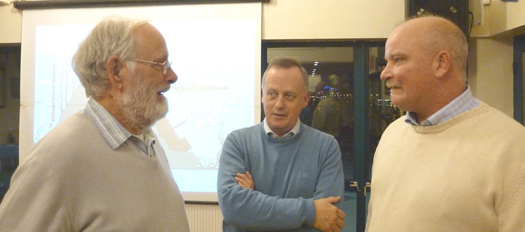
Tim Magennis (left) seen recently at a DBOGA meeting with fellow gaffers Ian Malcolm and Sean Cullen
His own boat these days is the 25ft Marguerite, a lovely little clipper-bowed gaff sloop designed in 1896 by Herbert Boyd, who later designed the Howth 17s in 1898. A great friend and fellow owner of another vintage Boyd boat, the 26ft Eithne from 1893, is Patrick Cullen's son Sean, who is very much an Irish seafarer these days – he commands one of the national maritime survey vessels, a long way indeed from racing aboard Sandefjord from Cape Town to Rio as a very young seafarer in 1971.
Tim's seagoing interests are many. He sailed many miles offshore with Don Street of Glandore aboard Don's famous ocean-crossing Iolaire. And more recently, while sailing across the Bay of Biscay aboard the square rigger Jeanie Johnston on a pilgrimage with a difference to Santiago de Compostela, his mobile phone rang, and the connection lasted just long enough to tell him he'd become a grandfather for the first time.
That's the way it is with Tim Magennis. There's always something new on the horizon. And there's quite a past too, for this is a man who once upon a time sailed right round the world on a fine gaff ketch when all the world was young, and everything was possible. So when the world of gaff rig comes to Dublin Bay in six weeks time, there'll be someone there to welcome them, a man who really does know what seafaring under gaff rig is all about.



























